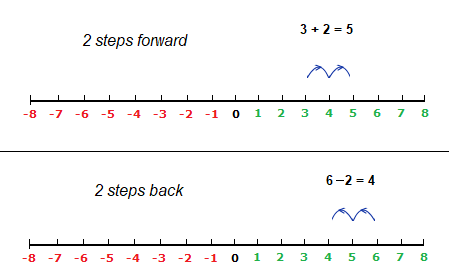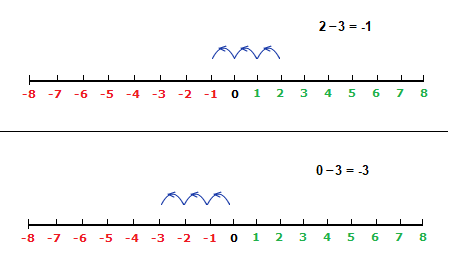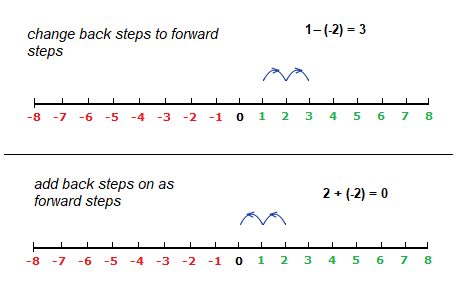This page looks to give a good introduction to arithmetic involving both positive and negative whole numbers in Math, which are classed as Integers.
With set notation, the set of all Integers is denoted by \Z.
The first numbers we usually encounter are positive numbers.
Numbers such as 1, 55, 438.
The time does arrive though, when we encounter both positive and negative numbers.
Where we see negative numbers that have a value that is less than zero.
Such as -2, -45, -166.
For example thermometers in colder months can often record negative temperatures in some countries.

Like positive numbers, negative numbers have been around for quite some time.
As mentioned, when they’re whole numbers and combined with positive whole numbers as a group, they make up the Integers.
……. -3 , -2 , -1 , 0 , 1 , 2 , 3 ……
Number Line
Looking at a number line is a good way of visualizing the concept of positive and negative numbers.
Below is a number line from -8 to 8 .

Once we go below 0, the same order of numbers is the same as above 0, but now each number has a minus sign sign alongside it.
Positive and Negative Numbers,
Adding and Subtracting
We learn very early in Math how to effectively add and subtract positive numbers when required.
3 + 2 = 5 , 6 − 2 = 4
Sums like the ones above can be done by simply taking steps forward or back on a suitable number line.

Understanding addition and subtraction sums that also include negative numbers is a similar idea, taking steps in the right direction, but we can also go below zero.
2 − 3 = -1 , 0 − 3 = -3

Adding or Subtracting a Negative Number
Now we need to be clear about what happens when subtracting or adding a negative number.
The key points to understand and remember, are that when you subtract a negative number, what you’re really doing is adding it on.
Also, when you add a negative number, then you’re in fact subtracting it.
a) 1 − (-2) = 1 + 2 = 3
You are taking away 2 backwards steps, switching them to 2 forward steps.
b) 2 + (-2) = 2 − 2 = 0
You’re adding 2 backwards steps on.

Examples
1.1 10 + (-3) = 10 − 3 = 7
1.2 7 − (-4) = 7 + 4 = 11
1.3 -4 + 1 = -3
1.4 -4 − 1 = -5
1.5 A hot dog stands profits and losses over 4 days were as follows.
DAY 1 ( $92 ) , DAY 2 ( -$18 ) , DAY 3 ( $59 ) , DAY 4 ( -$6 )
What is the total profit or loss over the 4 days?
Solution
92 + (-18) + 59 + (-6) = 92 − 18 + 59 − 6 = 127
Total profit for the 4 days was $232.
Multiplying Positive and Negative Numbers
For the case of multiplying positive and negative numbers. Care again needs to be taken with which signs are where.
Two numbers multiplied together with the same sign, give a positive number.
+ x + = + – x – = +
Two numbers multiplied together with a different sign, give a negative number
+ x – = – – x + = –
Examples
2.1 10 × 2 = 20 2.2 -3 × 3 = -9 2.3 2 × -4 = -8 2.4 -5 × -4 = 20
We often need to be a bit more careful when multiplying more than 2 numbers together though, when positive and negative numbers are involved.
Move 1 step at a time.
2.5 (-1) × 3 × (-2) => (-1) × 3 = -3 , -3 × -2 = 6
(-1) × 3 × (-2) = 6
2.6 (-2) × (-3) × (-2) => (-2) × (-3) = 6 , 6 × (-2) = -12
(-2) × (-3) × (-2) = -12
Dividing
Division with negative and positive numbers does share some similarities with multiplication.
Like with multiplication, when dividing we need to make sure we pay attention to the location of any – sign.
If both numbers in a division have the same sign, the answer is POSITIVE.
\tt{\frac{\color{green}+ve}{\color{green}+ve}} = +VE \tt{\frac{\color{darkred}-ve}{\color{darkred}-ve}} = +VE
If the numbers in a division have different signs, the answer is NEGATIVE.
\tt{\frac{\color{green}+ve}{\color{darkred}-ve}} = −VE \tt{\frac{\color{darkred}-ve}{\color{green}+ve}} = −VE
Examples
3.1
\frac{36}{6} = 6
\frac{36}{6} = 6
3.2
\frac{{\text{-}}24}{8} = -3
\frac{{\text{-}}24}{8} = -3
3.3
\frac{18}{{\text{-}}9} = -2
3.4
\frac{20}{{\text{-}}5} = -4
- Home ›
- Arithmetic/Numbers › Negative, Positive Numbers